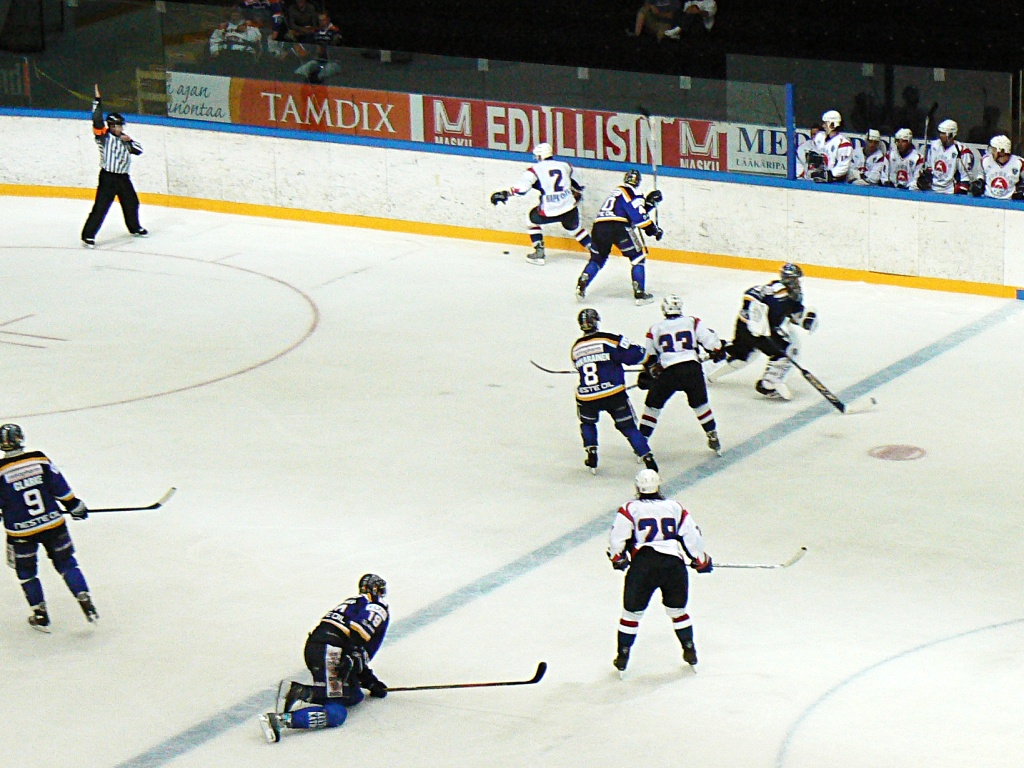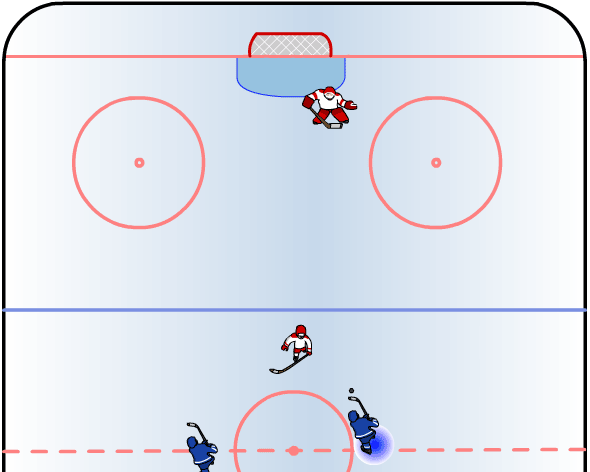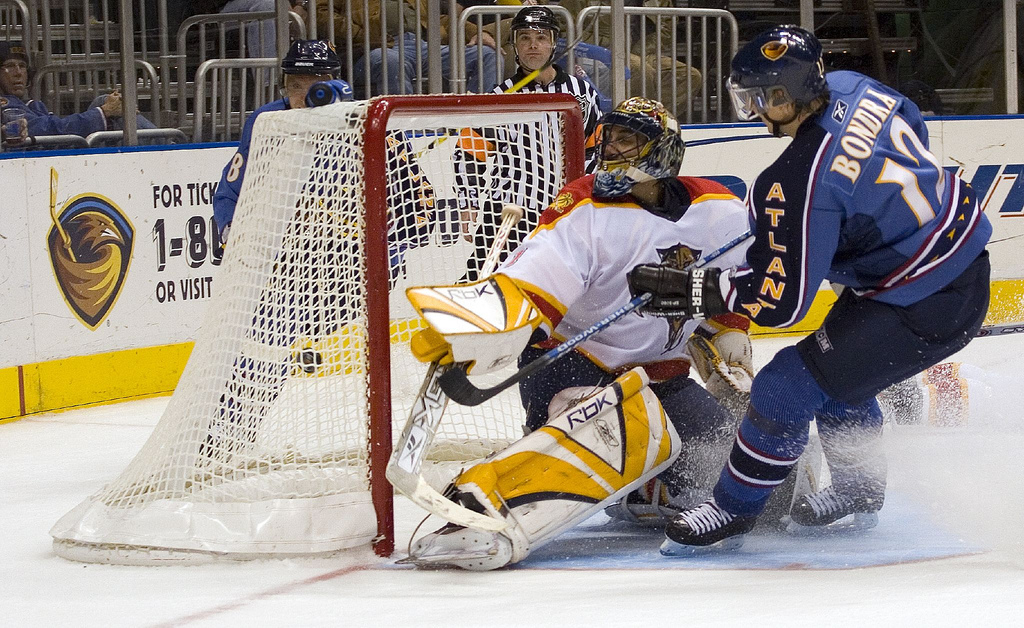|
Leif Rohlin
Leif Johan Rohlin (born February 26, 1968) is a former professional ice hockey defenceman who spent 2 seasons in the National Hockey League with the Vancouver Canucks and enjoyed a long career in Europe. He is currently the General Manager of VIK Västerås HK of the second level of Swedish ice hockey, HockeyAllsvenskan. Playing career Rohlin was selected 33rd overall in the 1988 NHL Entry Draft by the Vancouver Canucks, following a strong performance at the 1988 World Junior Championships. While considered a strong NHL prospect, he continued to ply his trade in Sweden with his hometown club, Västerås IK. Rohlin's game would continue to evolve in Sweden, although he proved difficult for the Canucks to sign. By the mid-1990s, he had earned the tag of 'best defender outside the NHL'. Strong performances at the 1994 Winter Olympics and 1995 World Championships, along with a monster 1994–95 season in the Swedish Elite League in which he scored 15 goals and 30 points in just 39 ... [...More Info...] [...Related Items...] OR: [Wikipedia] [Google] [Baidu] |
Vancouver Canucks
The Vancouver Canucks are a professional ice hockey team based in Vancouver. They compete in the National Hockey League (NHL) as a member of the Pacific Division (NHL), Pacific Division of the Western Conference (NHL), Western Conference, and play their home games at Rogers Arena. Bruce Boudreau is the head coach, Jim Rutherford serves as the president of hockey operations, and Patrik Allvin serves as the general manager. The Canucks joined the league in 1970–71 NHL season, 1970 as an expansion team along with the Buffalo Sabres. In its NHL history, the team has advanced to the Stanley Cup Finals three times, losing to the New York Islanders in 1982 Stanley Cup Finals, 1982, the New York Rangers in 1994 Stanley Cup Finals, 1994 and the Boston Bruins in 2011 Stanley Cup Finals, 2011. They have won the Presidents' Trophy in back-to-back seasons as the team with the league's best regular-season record in the 2010–11 NHL season, 2010–11 and 2011–12 NHL season, 2011–12 se ... [...More Info...] [...Related Items...] OR: [Wikipedia] [Google] [Baidu] |
1986–87 Division 1 Season (Swedish Ice Hockey)
1986–87 was the 12th season that Division 1 operated as the second tier of ice hockey in Sweden, below the top-flight Elitserien (now the Swedish Hockey League). Format Division 1 was divided into four starting groups of 10 teams each. The top two teams in each group qualified for the Allsvenskan, while the remaining eight teams had to compete in a qualifying round. The teams were given zero to seven bonus points based on their finish in the first round. The top team from each qualifying round qualified for the playoffs. The last-place team in each of the qualifying groups had to play in a relegation series in an attempt to avoid relegation to Division 2. Of the eight teams in the Allsvenskan, the top team qualified directly for promotion to the Elitserien (now the SHL), while the second place team qualified for the Kvalserien, which offered another opportunity to be promoted. The third to sixth place teams in the Allsvenskan qualified for the playoffs. The two playoff winners ... [...More Info...] [...Related Items...] OR: [Wikipedia] [Google] [Baidu] |
Penalty (ice Hockey)
A penalty in ice hockey is a punishment for an infringement of the rules. Most penalties are enforced by sending the offending player to a penalty box for a set number of minutes. During the penalty the player may not participate in play. Penalties are called and enforced by the referee, or in some cases, the linesman. The offending team may not replace the player on the ice (although there are some exceptions, such as fighting), leaving them short-handed as opposed to full strength. When the opposing team is said to be on a '' power play'', they will have one more player on the ice than the short-handed team. The short-handed team is said to be "on the penalty kill" until the penalty expires and the penalized player returns to play. While standards vary somewhat between leagues, most leagues recognize several common varieties of penalties, as well as common infractions. The statistic used to track penalties is called "penalty minutes" and abbreviated to "PIM" (spoken as singl ... [...More Info...] [...Related Items...] OR: [Wikipedia] [Google] [Baidu] |
Point (ice Hockey)
In ice hockey, point has three contemporary meanings. Personal stat A point is awarded to a player for each goal scored or assist earned. The total number of goals plus assists equals total points. The Art Ross Trophy is awarded to the National Hockey League (NHL) player who leads the league in scoring points at the end of the regular season. Team stat Points are also awarded to assess standings (or rankings). Historically, teams were awarded two points for each win, one point for each tie and no points for a loss. Such a ranking system, implemented primarily to ensure a tie counted as a "half-win" for each team in the standings, is generally regarded as British and/or European in origin and as such adopted by the National Hockey League which was founded in Canada where leagues generally used ranking systems of British origin. Awarding points in the standings contrasts with traditional American ranking systems favored in sports originating within the United States where today th ... [...More Info...] [...Related Items...] OR: [Wikipedia] [Google] [Baidu] |
Assist (ice Hockey)
In ice hockey, an assist is attributed to up to two players of the scoring team who shot, passed or deflected the puck towards the scoring teammate, or touched it in any other way which enabled the goal, meaning that they were "assisting" in the goal. There can be a maximum of two assists per goal. The assists will be awarded in the order of play, with the last player to pass the puck to the goal scorer getting the primary assist and the player who passed it to the primary assister getting the secondary assist. Players who gain an assist will get one point added to their player statistics. Despite the use of the terms "primary assist" and "secondary assist", neither is worth more than the other, and neither is worth more or less than a goal. Assists and goals are added together on a player's scoresheet to display that player's total points. Special cases If a player scores off a rebound given up by a goaltender, assists are still awarded, as long as there is no re-possession by ... [...More Info...] [...Related Items...] OR: [Wikipedia] [Google] [Baidu] |
Goal (ice Hockey)
In ice hockey, a goal is scored when the puck entirely crosses the goal line between the two goal posts and below the goal crossbar. A goal awards one point to the team attacking the goal scored upon, regardless of which team the player who actually deflected the puck into the goal belongs to (see also own goal). Typically, a player on the team attempting to score shoots the puck with their stick towards the goal net opening, and a player on the opposing team called a goaltender tries to block the shot to prevent a goal from being scored against their team. The term goal may also refer to the structure in which goals are scored. The ice hockey goal is rectangular in shape; the front frame of the goal is made of steel tube painted red (blue in the ECHL because of a sponsorship deal with GEICO) and consists of two vertical goalposts and a horizontal crossbar. A net is attached to the back of the frame to catch pucks that enter the goal and also to prevent pucks from entering it ... [...More Info...] [...Related Items...] OR: [Wikipedia] [Google] [Baidu] |
Season (sports)
In an organized sports league, a typical season is the portion of one year in which regulated games of the sport are in session: for example, in Major League Baseball the season lasts approximately from the last week of March to the last week of September. In other team sports, like association football or basketball, it is generally from August or September to May although in some countries - such as Northern Europe or East Asia - the season starts in the spring and finishes in autumn, mainly due to weather conditions encountered during the winter. A year can often be broken up into several distinct sections (sometimes themselves called seasons). These are: a preseason, a series of exhibition games played for training purposes; a regular season, the main period of the league's competition; the postseason, a playoff tournament played against the league's top teams to determine the league's champion; and the offseason, the time when there is no official competition. Preseason ... [...More Info...] [...Related Items...] OR: [Wikipedia] [Google] [Baidu] |
Playoffs
The playoffs, play-offs, postseason or finals of a sports league are a competition played after the regular season by the top competitors to determine the league champion or a similar accolade. Depending on the league, the playoffs may be either a single game, a series of games, or a tournament, and may use a single-elimination system or one of several other different playoff formats. Playoff, in regard to international fixtures, is to qualify or progress to the next round of a competition or tournament. In team sports in the U.S. and Canada, the vast distances and consequent burdens on cross-country travel have led to regional divisions of teams. Generally, during the regular season, teams play more games in their division than outside it, but the league's best teams might not play against each other in the regular season. Therefore, in the postseason a playoff series is organized. Any group-winning team is eligible to participate, and as playoffs became more popular they ... [...More Info...] [...Related Items...] OR: [Wikipedia] [Google] [Baidu] |
Regular Season
In an organized sports league, a typical season is the portion of one year in which regulated games of the sport Sport pertains to any form of competitive physical activity or game that aims to use, maintain, or improve physical ability and skills while providing enjoyment to participants and, in some cases, entertainment to spectators. Sports can, ... are in session: for example, in Major League Baseball the season lasts approximately from the last week of March to the last week of September. In other team sports, like association football or basketball, it is generally from August or September to May although in some countries - such as Northern Europe or East Asia - the season starts in the spring and finishes in autumn, mainly due to weather conditions encountered during the winter. A year can often be broken up into several distinct sections (sometimes themselves called seasons). These are: a preseason, a series of exhibition games played for training purposes; a r ... [...More Info...] [...Related Items...] OR: [Wikipedia] [Google] [Baidu] |
Södertälje SK
Södertälje Sportklubb, also known as Södertälje SK and often referred to as SSK, is a Swedish professional ice hockey club playing in HockeyAllsvenskan, the second highest level of pro hockey in Sweden. Södertälje were charter members of Elitserien when the league was founded in 1975 and have since played 24 seasons in the league (1975–1978, 1980–1981, 1983–1992, 1996–1998, 2001–2006, 2007–2011). Södertälje SK's fan club is known as Supporterklubben History Södertälje SK was founded on 22 February 1902 and originally practiced gymnastics, track and field athletics, soccer, tug of war and speed skating. In 1907, a bandy section was established and the 1910s and 1920s saw the club scoring successes in competitive cycling. In January and February 1925, the club started practicing ice hockey. The club had played more seasons (74) in the Swedish ice hockey top division until Djurgårdens IF matched that feat in the 2014–15 SHL seaso ... [...More Info...] [...Related Items...] OR: [Wikipedia] [Google] [Baidu] |
IIHF Continental Cup
The Continental Cup is a second-level ice hockey tournament for European clubs (behind Champions Hockey League), begun in 1997 after the discontinuing of the European Cup. It was intended for teams from countries without representatives in the European Hockey League, with participating teams chosen by the countries' respective ice hockey associations. Hans Dobida served as chairman of the Continental Cup until 2018. Format The competition began in 1997–98 with 42 clubs from 26 countries, which expanded to 48 teams for the next two years. The tournament was played in seeded rounds of qualifying groups. There were three rounds of qualifying groups, with winners of qualifying groups progressing to the next round. The three winners of the third round groups entered the semifinals, along with the host club. The first round was held in September, the second in October, the third in November and the finals in December. In the 2000–01 season, with the European Hockey League on hiatu ... [...More Info...] [...Related Items...] OR: [Wikipedia] [Google] [Baidu] |




